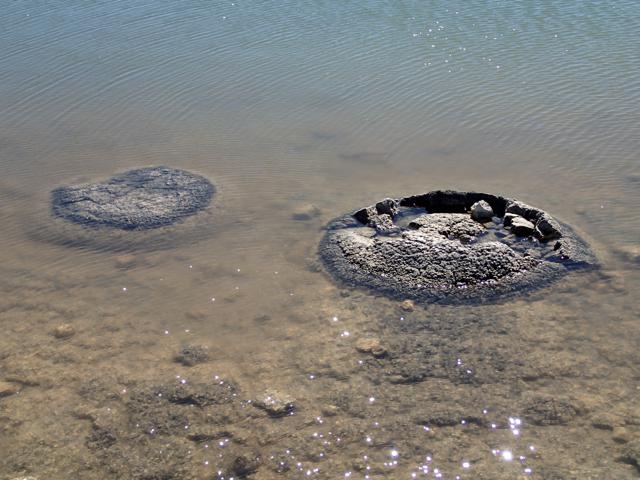VS's Geology Field Trip 2 - Stromatalites

VulcanSpirit
Richard & Alison Brunstrom
Thu 23 Apr 2015 08:07
Now stromatalites are really really interesting. Here are some, sitting in a brine lake just outside Cervantes WA, a few kilometres from the Pinnacles. You might think that they look like seriously boring chunks of undistinguished rock lying in a hot smelly puddle at the backend of nowhere and you might be right. But these are really really important chunks of rock. They’re alive for one thing, and immensely important in the history of our planet and even our existence on it today. Things don’t get much more important than that. And WA is the best place in the whole world to see them! Here they are at Lake Thetis, Cervantes WA, with the boardwalk for scale (the limestone shelf here is actually a living mat of cyanobacteria which need protection from trampling): Strmatolites are actually colonies of single-celled photosynthetic cyanobacteria. The earliest ones known appear as quite unarguable fossils at 3.8 BILLION years old (!!), in rocks elsewhere in WA. Modern versions are essentially unchanged. This is almost incredible. The Earth itself didn’t form until about 4.5bya, so these are astonishingly old lifeforms. Cyanobacteria are prokaryotes, that is to say single-celled organisms without a nucleus (as opposd to eukaryotes which have a nucleus contain DNA, which evolved from prokaryotes and gave rise to all other life (including us).  The bacteria capture carbonate from the water (they can only live where there is a carbonate source, in freshwater or salt) and turn it into limestone. The bacteria, being photosynthetic, migrate to the surface of the stone and live there in a film. Over a very long time (growing at perhaps half a millimetre a year) a large lump of limestone forms, which is the stromatolite we see today. These ones are about 3-4000 years old and date from the most recent fall in sea level in these parts. In cross-section they show a regular banded growth pattern which is absolutely characteristic. But, not only are they almost unchanged over several billion years (and must therefore be an extremely successful design) they have played an absolutely crucial role in Earth’s early history. Until about 2.7bya the Earth had only about 1% oxygen in its atmosphere - the rest was methane, nitrogen and carbon dioxide. By combining ferrous iron dissolved in the oceans with the oxygen waste product of the cyanobacteria ferric oxide was produced and precipitated out as banded ferric oxide (the source of modern WA’s mineral wealth). Once all the ferrous ions in the whole world’s oceans had been converted in this way (how amazing is that?!) excess oxygen began to accumulate in the atmosphere - leading eventually to life as we know it today. Amazing, huh?  But that’s not all. Stromatolites have a fascinating growth pattern. Because they are photosynthetic the bacteria follow the sun, and their resulting growth patterns fossilise beautifully. It is possible to count the number of days in an ancient year by looking at their growth ‘rings’ at microscopic level as the ancient bacteria aligned themselves with each day’s sun. Using this method it has been possible to calculate day length and number of days per year in 850 million year old Australia stromatolites. Incredibly, this shows that at that time there were about 400, 20 hour days per year. The Earth has been slowing down ever since (it still is); it is thought this is caused by friction from the tidal bulge resulting from the Moon’s gravity. Amazing, or what? |